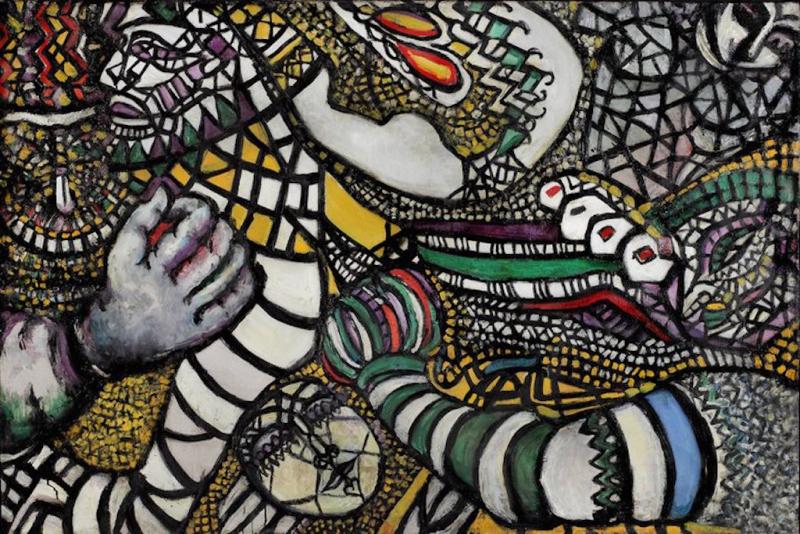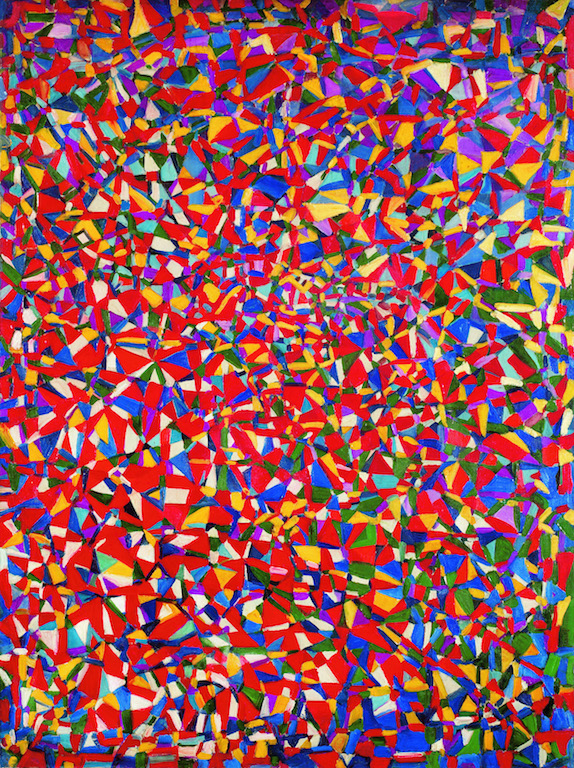Fahrelnissa Zeid, Tate Modern review - rediscovering a forgotten genius | reviews, news & interviews
Fahrelnissa Zeid, Tate Modern review - rediscovering a forgotten genius
Fahrelnissa Zeid, Tate Modern review - rediscovering a forgotten genius
How a major 20th century painter was erased from history

I can’t pretend to like the work of Fahrelnissa Zeid, but she was clearly an exceptional woman and deserves to be honoured with a retrospective. She led a privileged life that spanned most of the 20th century; born in Istanbul in 1901 into a prominent Ottoman family, many of whom were involved in the arts, she died in 1991.
She studied at the Academy of Fine Arts for Women but, when she was 19, married a wealthy businessman and had three children. That could had been the end of the story except that her enthusiasm for art was nurtured by visits to European museums and galleries and she continued to paint; in 1928 she went to Paris to attend the Académie Ranson as a mature student. The following year she was one of the first women accepted at the Fine Arts Academy in Istanbul.
 In 1934 she divorced her husband and married Prince Zeid bin Al Hussein, brother of King Faisal of Iraq. From then on, she managed to juggle the dual roles of a diplomat’s wife – her husband was Iraqi ambassador first to Germany, then to Britain – and an artist. She kept a studio in Paris to which she would retreat from the social engagements she was obliged to fulfill, worked ferociously on canvases of ever increasing size and ambition, and was exhibited to great acclaim in Istanbul, London and Paris.
In 1934 she divorced her husband and married Prince Zeid bin Al Hussein, brother of King Faisal of Iraq. From then on, she managed to juggle the dual roles of a diplomat’s wife – her husband was Iraqi ambassador first to Germany, then to Britain – and an artist. She kept a studio in Paris to which she would retreat from the social engagements she was obliged to fulfill, worked ferociously on canvases of ever increasing size and ambition, and was exhibited to great acclaim in Istanbul, London and Paris.
During the war years she suffered bouts of depression, which fed into her paintings and lends them a brooding intensity. With its angularity, expressive drama and confrontational stare, her striking Self-portrait of 1944 (pictured above right) reminds me of an Egon Schiele. With its flattened space and oriental flavour, Third-class Passengers, 1943, is like a sombre Matisse. Black lines course like tears down Three Moments in a Day and a Life, 1944; with its figures huddling in flattened space, this symbolic landscape is reminiscent of the darkly introspective paintings of Edvard Munch.
Fight Against Abstraction, 1947 (main picture), reflects Zeid’s reluctance to embrace the post-Cubist abstraction that filled Parisian galleries at the time. One can just make out four figures trapped within the densely patterned ground; one hand remains three-dimensional but the other limbs and faces have been flattened and fragmented into a kaleidoscope of tiny geometric shapes framed by black lines resembling the leading in a stained glass window or the cement in a mosaic.
 Soon the figures would merge with the ground to the point of being nearly invisible, before disappearing altogether. Resolved Problems, 1948, is like a joyous celebration of a struggle that has found resolution (pictured left). The black lines have disappeared, leaving a crystalline web of vibrant colour that anticipates op and kinetic art but, inspired by Byzantine mosaics and stained glass, creates a unique fusion between Eastern and Western influences.
Soon the figures would merge with the ground to the point of being nearly invisible, before disappearing altogether. Resolved Problems, 1948, is like a joyous celebration of a struggle that has found resolution (pictured left). The black lines have disappeared, leaving a crystalline web of vibrant colour that anticipates op and kinetic art but, inspired by Byzantine mosaics and stained glass, creates a unique fusion between Eastern and Western influences.
The black returns with a vengeance in My Hell, 1951 (pictured below). The canvas is over five metres long; Zeid tacked it to the walls of her Paris studio, wrapping it around one corner so that it became as immersive as an installation. Made up of small interlocking shapes in red, yellow, white and black, the picture is like a vast mosaic of forms that tumble and roil with endless dynamism, sucking you into their restless orbit and propelling your eye towards the black, mouth-like shape at the core.
A cross between Western geometric abstraction and the geometric ornamentation of Islamic art, it combines the visual impact of easel painting with the physical experience of design on an architectural scale. The picture was included in Zeid’s 1954 solo show at the Institute of Contemporary Arts, then the most progressive gallery in London.
In 1958 disaster struck. Following a coup d’etat, the entire Iraqi royal family was murdered; Zeid and her husband remained unharmed but were given 24 hours to vacate the embassy. Traumatised by events, she stopped painting for two years. "Instead of the brilliant kaleidoscope that once seemed to surround me”, she wrote, “I can only perceive... a winding labyrinth of hard and heavy black lines.” She started painting again, though, with a renewed vigour and ambition which are evident in huge canvases such as Break of the Atom and Vegetal Life, 1962, whose title suggests a link between her fractured forms and the splitting of the atom.
 In 1970 Zeid’s husband died, and five years later she moved to Jordan to be near her son, Prince Raad, and his family. She set up a studio in Amman and began to hold classes for women artists. Meanwhile, she had abandoned abstraction to focus on portraits of her friends and family; with their simplified forms and large, black rimmed eyes they are reminiscent of the depictions of the dead painted on Roman sarcophagi or the horribly mannered portraits of Bernard Buffet whose phenomenal success in Paris during the 1950s was part of a backlash against abstraction.
In 1970 Zeid’s husband died, and five years later she moved to Jordan to be near her son, Prince Raad, and his family. She set up a studio in Amman and began to hold classes for women artists. Meanwhile, she had abandoned abstraction to focus on portraits of her friends and family; with their simplified forms and large, black rimmed eyes they are reminiscent of the depictions of the dead painted on Roman sarcophagi or the horribly mannered portraits of Bernard Buffet whose phenomenal success in Paris during the 1950s was part of a backlash against abstraction.
Now that Zeid had quit Europe, the process of erasing her from history began. In Amman she continued to exhibit alongside her students, but in the west her portraits were ignored in favour of her earlier abstracts and, gradually, they too were forgotten. Its a process that happens to many artists, but women whose success often seems to reside on the force of their personalities, are especially vulnerable to it.
This retrospective, therefore, is a welcome reminder not just of a powerful personality and the contribution she made to 20th century art, but also of the ease with which an individual can be erased from the pantheon.
- Fahrelnissa Zeid at Tate Modern until 8 October 2017
- Read more visual arts coverage on theartsdesk
rating
Explore topics
Share this article
The future of Arts Journalism
You can stop theartsdesk.com closing!
We urgently need financing to survive. Our fundraising drive has thus far raised £49,000 but we need to reach £100,000 or we will be forced to close. Please contribute here: https://gofund.me/c3f6033d
And if you can forward this information to anyone who might assist, we’d be grateful.

Subscribe to theartsdesk.com
Thank you for continuing to read our work on theartsdesk.com. For unlimited access to every article in its entirety, including our archive of more than 15,000 pieces, we're asking for £5 per month or £40 per year. We feel it's a very good deal, and hope you do too.
To take a subscription now simply click here.
And if you're looking for that extra gift for a friend or family member, why not treat them to a theartsdesk.com gift subscription?
more Visual arts
 'We are bowled over!' Thank you for your messages of love and support
Much-appreciated words of commendation from readers and the cultural community
'We are bowled over!' Thank you for your messages of love and support
Much-appreciated words of commendation from readers and the cultural community
 Lee Miller, Tate Britain review - an extraordinary career that remains an enigma
Fashion photographer, artist or war reporter; will the real Lee Miller please step forward?
Lee Miller, Tate Britain review - an extraordinary career that remains an enigma
Fashion photographer, artist or war reporter; will the real Lee Miller please step forward?
 Kerry James Marshall: The Histories, Royal Academy review - a triumphant celebration of blackness
Room after room of glorious paintings
Kerry James Marshall: The Histories, Royal Academy review - a triumphant celebration of blackness
Room after room of glorious paintings
 Folkestone Triennial 2025 - landscape, seascape, art lovers' escape
Locally rooted festival brings home many but not all global concerns
Folkestone Triennial 2025 - landscape, seascape, art lovers' escape
Locally rooted festival brings home many but not all global concerns
 Sir Brian Clarke (1953-2025) - a personal tribute
Remembering an artist with a gift for the transcendent
Sir Brian Clarke (1953-2025) - a personal tribute
Remembering an artist with a gift for the transcendent
 Emily Kam Kngwarray, Tate Modern review - glimpses of another world
Pictures that are an affirmation of belonging
Emily Kam Kngwarray, Tate Modern review - glimpses of another world
Pictures that are an affirmation of belonging
 Kiefer / Van Gogh, Royal Academy review - a pairing of opposites
Small scale intensity meets large scale melodrama
Kiefer / Van Gogh, Royal Academy review - a pairing of opposites
Small scale intensity meets large scale melodrama
 Jenny Saville: The Anatomy of Painting, National Portrait Gallery review - a protégé losing her way
A brilliant painter in search of a worthwhile subject
Jenny Saville: The Anatomy of Painting, National Portrait Gallery review - a protégé losing her way
A brilliant painter in search of a worthwhile subject
 Abstract Erotic, Courtauld Gallery review - sculpture that is sensuous, funny and subversive
Testing the boundaries of good taste, and winning
Abstract Erotic, Courtauld Gallery review - sculpture that is sensuous, funny and subversive
Testing the boundaries of good taste, and winning
 Edward Burra, Tate Britain review - watercolour made mainstream
Social satire with a nasty bite
Edward Burra, Tate Britain review - watercolour made mainstream
Social satire with a nasty bite
 Ithell Colquhoun, Tate Britain review - revelations of a weird and wonderful world
Emanations from the unconscious
Ithell Colquhoun, Tate Britain review - revelations of a weird and wonderful world
Emanations from the unconscious
 Rachel Jones: Gated Canyons, Dulwich Picture Gallery review - teeth with a real bite
Mouths have never looked so good
Rachel Jones: Gated Canyons, Dulwich Picture Gallery review - teeth with a real bite
Mouths have never looked so good

Add comment